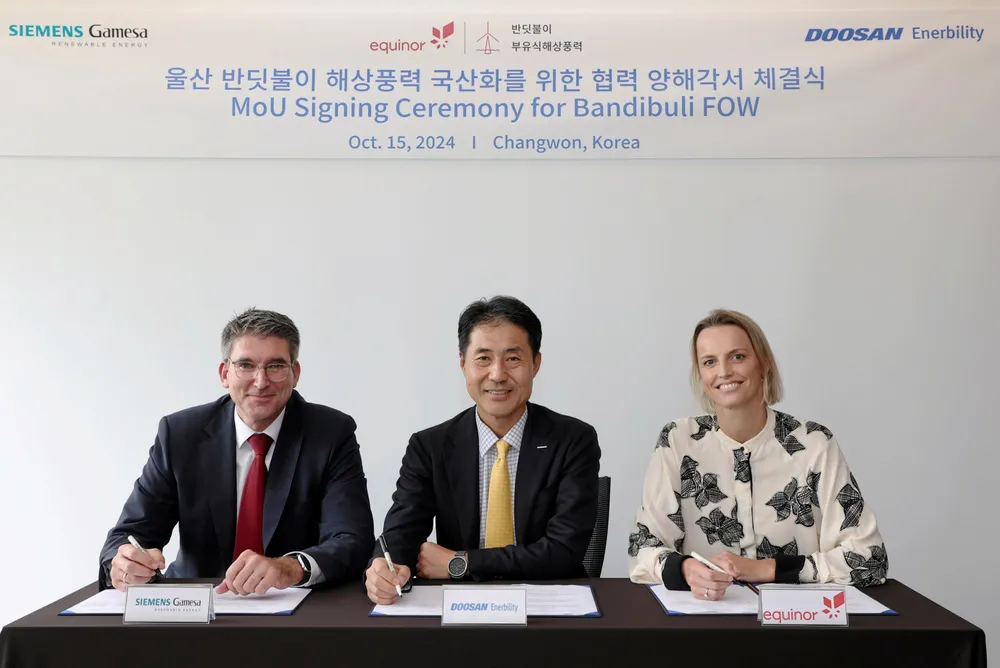Equinor's Firefly South Korea win hailed as floating wind milestone
Norwegian group's 750MW project secures power deal that positions it as large-scale sector pioneer

South Korea named Equinor’s Firefly project among the winners in its 2024 offshore wind auction round, a success hailed as a key milestone for the floating wind sector globally.
The Norwegian group’s 750MW Firefly was the sole winner – and only bidder – in the floating category, South Korea’s energy ministry announced today.
Firefly, also known as Bandibuli, will be located 60-70km off the coast of Ulsan.
Equinor said if it signs a power deal a Final Investment Decision is planned for in the next one to two years, with first power production expected in the early 2030s.
“We will not take on significant financial commitments or make a Final Investment Decision until we are confident the project can deliver competitive returns within our guided range.”
Juan Frias, a principal consultant and head of offshore wind auctions at consultancy OWC, said: “Firefly represents a global milestone for floating wind, being the largest floating wind project with a route to market worldwide and the first commercial floating wind project outside Europe.
“The scale, site conditions and complexity of Firefly make it a real frontier project.”
Firefly was one of four offshore wind projects to secure 20-year power deals in what was the first South Korean auction to place fixed-bottom and floating offshore wind in two separate categories.
Three fixed-bottom projects were allocated to Korean companies totalling 1.14GW of capacity. The three winners — out of a total seven competing projects — were a 532MW development by Anma Offshore Wind project, Vena Energy’s 500MW Taean wind farm and Daehan Green Power's 104MW Yawol project.
South Korea also awarded deals for six onshore wind projects for a total 199MW out of 300MW on offer. Frias said the onshore part of the round was undersubscribed due to the growing competitiveness of corporate power purchase agreements as an alternative route to market.
South Korea's government increased the price ceiling for the latest tender, setting an upper rate of KRW176,565 ($122) per MWh for both fixed-bottom and floating offshore wind projects.
Announcing the results, it said it would bring forward the next round of wind power bidding to the first half of 2025.
The Energy ministry said: “Starting next year, we plan to bring forward the announcement period to the first half of the year and, if necessary, additional announcements in the second half of the year, considering the bidding demand.”
“We will also continue to pursue institutional improvements, such as the establishment of a public-led separate bidding market and improvements to security indicators.”
South Korea is starting a push to tender off 7-8GW of offshore wind over a two-year period. The nation wants to have 14.3GW in place by 2030.
Frias added: “The release of the auction results ahead of the schedule and despite the current political turmoil, underscores Korea's commitment to establish a leading offshore wind sector helping to decarbonise the country. This announcement provides much needed confidence to the market, international developers and investors.”
Offshore wind reforms
A National Assembly subcommittee subjected seven different proposals to review in November, in an attempt to prioritise passage of the bill.
The next scheduled meeting of the subcommittee was impacted by the political turmoil that followed an attempt by President Yoon Suk Yeol to declare martial law.
Lobby groups for renewable energy in South Korea have also been calling for a rationalisation of spatial planning for offshore wind. Existing arrangements have been impacted by national defence and fishing industry concerns.
"Due to the nature of spatial planning, which requires carefully organising the use of maritime space, any increase in projects initiated under existing individual laws before planning is finalized will inevitably complicate the introduction of the new system.
"This could lead to recurring issues in Korea, like permitting delays, low project predictability, and low public acceptance."